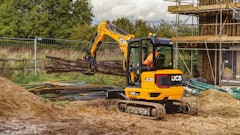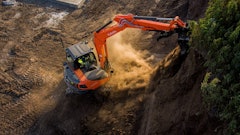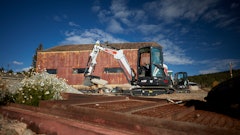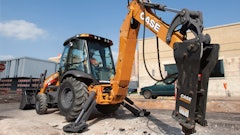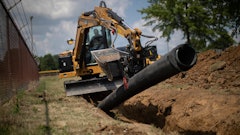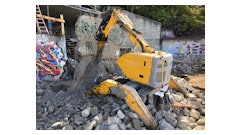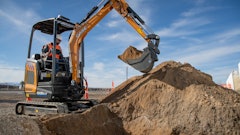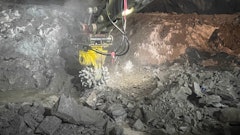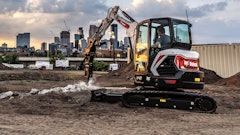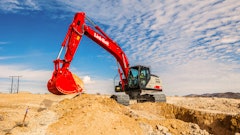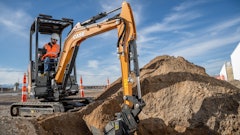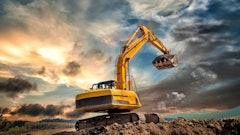
Compact excavators have really come of age. They have found a niche in the construction market for smaller trenching and digging applications, as well as jobs that require maneuvering in tight and confined spaces.
"A compact excavator is now one of the first machine purchases a contractor will make," indicates David Caldwell, Komatsu America. "Many contractors find that, despite their compact design, they are able to perform a variety of tasks. Compact excavators are now replacing the tractor-loader-backhoe on many jobsites, because they are able to get in and out of confined areas and are easier to transport."
Depending on who you ask, compact excavators typically weigh up to about 6 metric tons, although some manufacturers include any model under 18,000 lbs. Regardless, the compact's lighter weight is an advantage when it comes to both transportation and maneuverability.
"Compact excavators are an efficient tool on a construction site," says Brian Rabe, Mustang Mfg. "With their ability to swing the boom, these machines excel at digging along foundations, fence lines or around obstacles, or digging a square hole without repositioning the machine. The standard dozer blade for stability and backfilling can help clean up a jobsite without the assistance of another piece of equipment. Also, their compact size means they can gain access to smaller jobsites than larger units. Additionally, transport costs are reduced."
With their growing popularity come a number of machine choices. So how do you determine which is the right fit?
"Refer to your business plan and understand what applications you will be performing in the future," says Dave Wolf, Case Construction. "This may require sizing a machine today to meet future tasks [in order to] take full advantage of the capital investment. Always size a machine to fit the application."
To do this properly, ask yourself the following questions.
How much does it weigh?
Weight is important when it comes to transporting the equipment. Many compact excavators can be hauled with a 1-ton or lighter pickup truck. That means you won't need a more costly CDL license and specially trained driver.
"Once you get beyond a certain weight, you will need to meet DOT regulations, have stickers on the truck, keep a log book, etc.," says Kendall Aldridge, IHI. "So if you don't need a large excavator, don't get one."
The compact's lighter weight can also be an advantage when working on existing landscape. "Contractors should look for a unit that will cause the least impact," says Rabe. "Keys are low ground pressure, zero tailswing and overall dimensions."
Low operating weight can also be an advantage in muddy soils, adds Aldridge. "If you're running in wet conditions all the time, you will want the lightest machine with the lowest ground pressure so you don't tear up the yard," he says.
Compacts in the 3- to 4-metric-ton class comprise about 40% of the compact market, notes Caldwell. "This class of machine is well suited for a variety of jobs, including utilities, building and landscape to name a few," he says. "However, a larger machine, like the PC45MR-3 (4 to 5 tons) or the PC55MR-3 (5 to 6 tons), will allow the operator more lift capacity, as well as additional dig depth and reach. This is important if the customer plans to lift heavy objects such as junction boxes, pipe and manhole covers."
For more extensive lifting, you may need to include additional counterweights for increased lift capacities, adds Wolf.
Of course, if you're doing mass excavation or large-scale demolition, you will need to move out of the compact class. "When you need to move vast amounts of material and load trucks, a mass production excavator is critical," Caldwell states. "Large scale demolition jobs often require the use of large hydraulic hammers, shears and grapples."
"Compact excavators excel at precision and accuracy," Rabe comments. "But due to their smaller size, they are not efficient large volume material movers. Compact excavators can do the same job as full-size machines, but they may take too much time to get the job done. So contractors should consider moving to a larger excavator when high-efficiency material moving is the primary application objective."
How deep do you need to dig?
Dig depth is likely the most important selection parameter with any size excavator. It defines the work envelope, Wolf points out. Like many manufacturers, Case offers multiple arm length options to meet different reach or dig depth needs.
Avoid the temptation to skimp on dig depth capability. Using the smallest model that can do the job could cause you to sacrifice productivity.
For example, if you need to dig 8-ft. holes, Aldridge advises against trying to get by with an 8.5-ft. dig depth machine. "That size machine will dig your 8-ft. holes. But as far as the speed of the machine and the productivity, it's just not there," he says. "You will want something with more power for more speed and productivity. You would want something more like 12 ft. That will give you the speed and power to dig down and work as fast as you can."
However, if most of your work is utility work that's just 3 to 4 ft. deep, you can get by with a smaller machine. If you do occasionally dig deeper, consider renting a larger unit for those jobs.
Most compacts will also have a dozer blade, which is a benefit for backfilling trenches. "Our three largest compacts have an available power angle blade to help reduce the time required to backfill a trench," notes Caldwell.
What attachments will you use?
Attachments define the hydraulic flow and coupler requirements for the excavator. Consider how much flow/pressure is required with the attachments you're likely to use, especially those with high-flow requirements, such as augers and breakers.
When considering attachments, also take a look at pump sizes/numbers/types, etc. needed to run those attachments, suggests Aldridge. "We have four pumps in our excavators," he says. "That gives you the ability to run multiple functions at once without losing power from one function to another."
Most manufacturers have progressed away from gear pumps to piston pumps, which require less horsepower to run. Granted, they're more expensive, but they're also more efficient and last longer.
"Piston pumps give you the same flow and working capabilities, but with less horsepower," says Aldridge. "That gives you the ability to run a smaller engine, and that leads to lower emissions and lower engine costs."
What weather will you work in?
Canopies and cabs for compact excavators have come a long way. With today's machines, more spacious platforms, pilot proportional joystick controls and standard load-sensing two-speed travel are just a few of the features you will find.
If a considerable amount of the jobs you're doing are in dusty conditions or inclement weather, you might want to consider upgrading to an enclosed cab with climate control options, suggests Wolf.
What are the ground conditions?
The ground conditions you're likely to encounter help determine if rubber or steel tracks are the better choice. Some manufacturers also offer steel track with rubber track pads. While this option is more expensive, it can provide a balance between the durability of steel with the softness of rubber.
"Almost all compacts are sold with rubber tracks. Rubber tracks don't tear up asphalt or concrete," Aldridge notes. "But steel tracks offer more traction and they're more durable for use in severe applications such as demolition. We sell a limited number of steel tracks, mostly in mountainous areas."
What is your work area clearance?
Compact excavators shine in tight and confined spaces. But you will want to evaluate just how tight and/or confined your typical work site is.
"For a new construction site, size is typically not an issue since there are no obstructions," says Rabe. "But with an existing jobsite, which may have trees and restricted access, size is critical."
The application is a key factor in machine sizing, he continues. For example, you may be able to fit a 6-metric-ton unit on the jobsite, but the application may only require a 3.5-metric-ton unit, which in turn may be a more efficient unit for the job.
Evaluating the work space will also help determine if a conventional, minimum radius or zero tailswing configuration is the best option. "Case compact excavators are all zero tailswing configuration, which allows them to be used in tight areas," Wolf asserts. "Compact excavators have the versatility to perform similar tasks that larger excavators do. Whether it's trenching, demolition or landscaping, compact excavators have the power and work envelopes to match the tasks."
Since conventional models are the most economical option, evaluate your applications to determine if the extra capital investment for a zero tailswing model is a necessity for your jobsite conditions.








